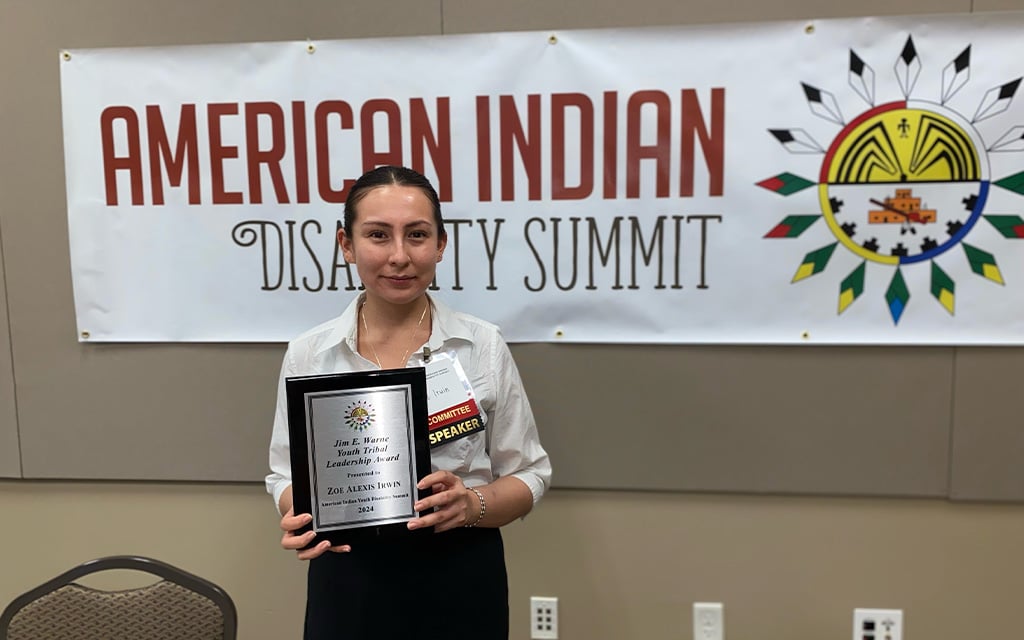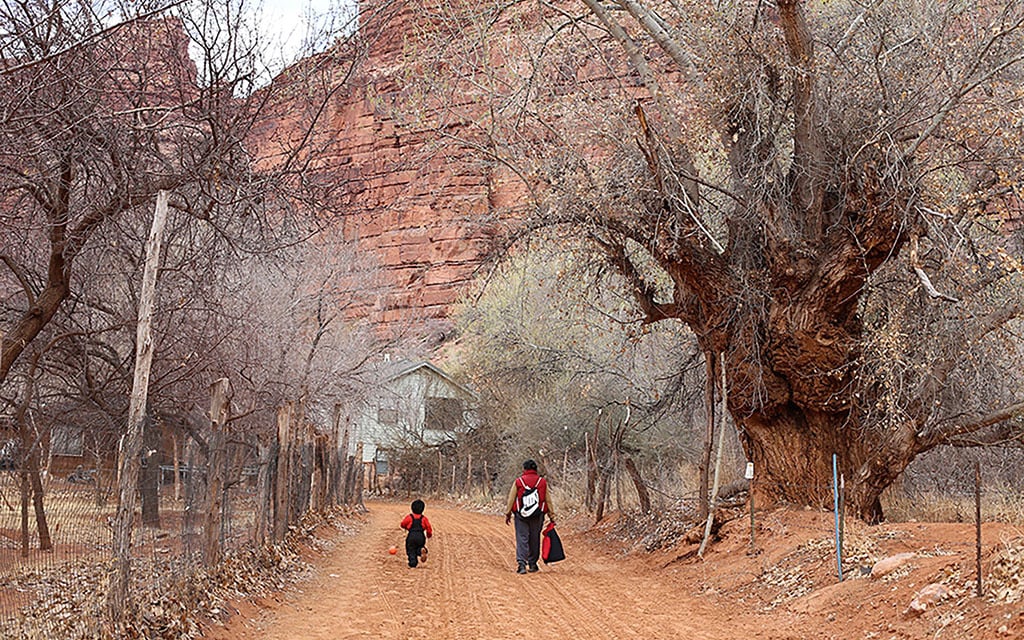
Zoë Alexis Irwin wins the Jim E. Warne Jr. Youth Tribal Leadership Award at the fourth annual American Indian Youth Disability Summit on Saturday, April 13. (Photo courtesy of Zoë Alexis Irwin)
PHOENIX – The fourth annual American Indian Youth Disability Summit, held on April 13, awarded a Youth Tribal Leadership Award to a college student whose interest in learning disabilities and her own speech disorder led her to study speech and hearing sciences at Arizona State University.
The youth summit explored topics ranging from mental health problems like post-traumatic stress disorder to voting accommodations made for those with disabilities in Arizona.
The youth summit was for American Indians up to age 26 with disabilities such as traumatic brain injuries, speech disabilities and mental illness. The event encouraged parents, caretakers, teachers and social workers to attend.
Kimberly Yellow Robe, founder and chairperson of the planning committee, started the youth event after speakers at the 2020 Annual American Indian Disability Summit discussed some topics deemed inappropriate for young people, who had to step out.
Yellow Robe asked those youth if they would be interested in having their own event, and the first youth summit came about within eight months. Yellow Robe is also a co-founder and co-chair of the planning committee for the Annual American Indian Disability Summit.
The virtual American Indian Youth Disability Summit focused on support and peer advocacy for young Native Americans with physical, neurological or developmental disabilities, Yellow Robe said.
According to Yellow Robe, the biggest barrier to getting care for Indigenous youth is not being informed about their options and a lack of trust that health care systems will understand and respect their culture. This event is meant to help children understand the options available to them.
The event started with a welcome and opening prayer, then keynote speaker Kenny Dodson and his mother, Trudy Billy, told the story of Dodson’s brain tumor at age 17. They told summit participants how they handled their traumatic experience as a family and encouraged others to not let a disability get in the way of life goals.
One session focused on how cultural values can be incorporated into a support plan for youth with anxiety and depression. Another talked about Arizona’s voting accommodations for people with disabilities, followed by an introduction to school-based behavioral health services and what is available to help youth with disabilities transition to employment.
Youth individualized education programs were featured in an individual session and were important to the winner of this year’s Jim E. Warne Jr. Youth Tribal Leadership Award. Zoë Alexis Irwin of the Rosebud Sioux Tribe was the recipient of the award, which is given to an “American Indian youth who demonstrates leadership qualities and personal strengths that help them overcome adversity in their community,” according to the Sonoran Center’s website. Warne facilitated the original talking circle about Native Americans with disabilities that later developed into the first American Indian Disability Summit.
Irwin has apraxia, also known as apraxia of speech or acquired apraxia of speech, a neurological speech and sound disorder “that affects the brain pathways involved in planning the sequence of movements involved in producing speech,” according to the National Institute on Deafness and Other Communication Disorders. A person with apraxia knows what they would like to say, but has trouble planning and ordering the words and sound movements.
In school, Irwin said she was surrounded by kids with other disabilities who also had individualized learning programs. She said the most common disabilities were speech disorders and learning disabilities that sometimes “can compound on one another.”
Irwin was diagnosed after performing a DIBELS (Dynamic Indicators of Basic Early Literacy Skills) assessment. Growing up, she remembers being pulled out of class each day and realizing that although she thinks differently than most people, there are people who think differently in the same way as she does.
“I just have to take my time and slow down with speaking,” Irwin said about how apraxia can affect her today. “It is just a case of learning how to communicate in a way that’s functional.”
Irwin said her apraxia made her shy and afraid to express herself growing up because she was afraid that she wouldn’t be able to articulate herself or that people wouldn’t understand her.
Irwin said she felt honored and excited about winning the leadership award. “I just want to encourage those kids that even though maybe what they’re going through is difficult or challenging, whether that be from a mental health standpoint, socioeconomic standpoint, or from just trying to figure life out, that there are always resources,” Irwin said.
The summit has helped Irwin by introducing her to Indigenous professionals in the health care field who inspired her, she said. She added that the summit can help youth with anything from writing a resume and applying for jobs to learning how to express themselves a little bit better.
“I think it helps reassure youth that having a disability isn’t who they are,” Irwin said.
Irwin is now a student at Arizona State University, scheduled to graduate this May, who is studying speech and hearing sciences at the College of Health Solutions. She also works as a registered behavior technician who uses behavior analysis for toddlers diagnosed with autistic spectrum disorder. Irwin had been working with developmentally disabled youth for five years.
“(The award) encourages me to do more studying in the field that I’m in. I, as a speech-language pathologist, come across a lot of different people, a lot of different methods of thinking and communicating. So I’m really, I’m just really motivated by this award,” Irwin said.


